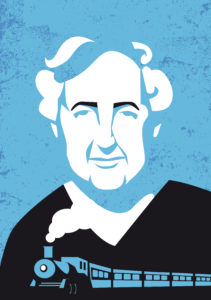
Agatha Christie — she wrote murder mysteries; we all know that. But this is probably what you didn’t know: Agatha Christie was also a pharmacist and the medical descriptions in her books were so accurate they actually saved lives. They even helped a solve real murders. I usually only blog about true crime, but for Agatha Christie I’m making an exception. Her books were so good they spilled over into real life. She’s a murder mystery comet with a true crime tail.

Agatha Christie, author and pharmacist
Not long before she became an author, during World War I, Agatha Christie trained as a nurse and then a pharmacy assistant. Two years later, she published her first murder mystery, The Mysterious Affair at Styles (1920). It introduced Hercule Poirot and featured a death by strychnine poisoning. A number of her following books centered on poisonings.
Thirty-eight books later, when World War II interrupted her life, and Christie stopped writing and worked in the pharmacy of the University College Hospital in London. She started publishing again the year before the war ended. In the end, she published more that 65 detective novels.
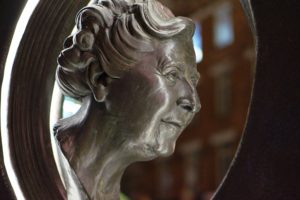
The pharmacist’s poisons
So many of those novels featured poison they attracted the attention of Uwe Künzler, a pharmacist in Berlin. He published an academic article about the poisons in Agatha Christie’s novels in 1999. Two years later, a German forensic pathologist, Benno Rießelmann, followed suit with a manuscript about Christie’s poisonings from a forensic, pathological, and toxicological perspective. And across the ocean, a pharmacist in Texas published an entire book on the topic, The Poisonous Pen of Agatha Christie, in 2011. His book features a 76-page list of all the compounds involved in Christie’s plotlines and analyses the 30 poisonings in her books.
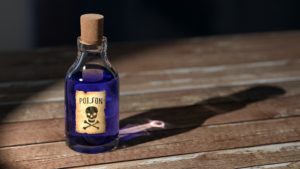
Poisons and medicines, that became poisons in Christie’s hands
Here are some of Christie’s most popular poisons, just to give you a (literary) taste:
Aconitine
A toxin from the monkshood plant. It appears in two of Christie’s novels.
Arsenic
A highly poisonous chemical element. Arsenic appears in no less than nine of Christie’s books.
Atropine
Atropine isn’t a poison, but rather a medication used to treat several different kinds of poisonings, such as from pesticides. Agatha Christie uses it as a plot point in two of her novels.
Barbiturate
Barbiturates are sedative drugs that can produce death in an overdose. They’re featured in thirteen of Christie’s murder mysteries.
Chloral hydrate
Chloral hydrate is a sedative and hypnotic drug, but don’t overuse it! In the hands of the wrong person, it can become a murder weapon, as three of Christie’s novels show.
Cocaine
A stimulant and popularly abused drug, cocaine appears in two of Christie’s books.
Digitalis
Derived from the foxglove plant family, digitalis became popular as a medicine for heart patients, but its popularity has been declining due to safety concerns. Agatha Christie employed digitalis as a murder weapon in six of her novels.
Morphine
An opiate and well-known pain medication, morphine becomes a poison in Christie’s hands. She features this drug in seven books.
Physostigmine
This drug derives from the African Calabar bean. Missionaries in what is now Nigeria noticed that people there used the bean as an ordeal poison to test defendants accused of witchcraft. Curious, the missionaries sent the beans to Great Britain, where physostigmine was isolated. Although highly poisonous, it does have some medical applications. Christie featured this unusual drug in two books, including Poirot’s last case.
Strophanthin
A cardiac medication similar to digitalis. Just don’t use too much, like the murderers did in two of Christie’s novels.
Strychnine
We all know this one. This colorless, odorless compound is a common ingredient both in rat poison and murder mysteries. Christie employed strychnine in five of her own mysteries.
Thallium
Thallium is a metal and chemical element. It used to be popular as rat poison, but many countries have prohibited it due to its popularity as a murder weapon. Christie used it only once, in The Pale Horse (1961), but this one plotline had the most impact on the real world. Her book helped solve real murders and save several lives.

The Pale Horse and poisoning cases
Copycat crimes have always been an unwanted side effect of murder mysteries. Someone might get an idea from a book and try it in real life.
On the flip side of the coin are “copycat” detectives and health care practitioners, who read an accurately-written novel like Agatha Christie’s, learn something from it, and employ that knowledge in real life. That’s precisely what happened with The Pale Horse. It contains an in-depth discussion of thallium poisoning symptoms – vomiting, diarrhea, hair loss, and nervous symptoms such as lethargy, numbness, black-outs and slurred speech. Some readers put that to good use.
In one case, a 19 month-old girl whose illness the doctors couldn’t diagnose owes her life to a nurse who had been reading The Pale Horse. She was admitted to the hospital, where a nurse told the attending physician she recognized the symptoms from Agatha Christie’s book. Testing confirmed thallium poisoning and the child could be saved. Her parents had been using thallium sulfate to kill cockroaches at home.
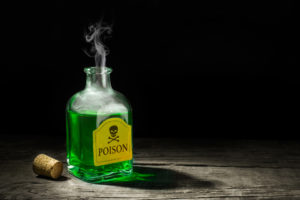
The Pale Horse and true crime
But it wasn’t just accidential poisonings the book solved. Ten years after the publication of The Pale Horse, in 1971, Bovingdon, Hertfordshire experienced a spate of poisonings. Workers at a photographic equipment company fell ill; two even died. Two things alerted law enforcement to thallium poisoning. One worker suggested it to a visiting health inspector, and the forensic pathologist on the case had read The Pale Horse and recognized the pattern. The pathologist was even able to find the metal in the ashes of one of the cremated victims by means of atomic absorption spectrometry. The perpetrator turned out to be Graham Young, the worker who had suggested thallium poisoning. He was sentenced to life imprisonment.
In 1975, The Pale Horse helped crack another case. A woman in South America wrote Agatha Christie a letter. She recognized thallium poisoning in a woman whose husband had been trying to poison her. “Of this I am absolutely certain,” she wrote, “that X, had I not read The Pale Horse, wouldn’t have survived.”
Why true crime fans should read Agatha Christie
True crime fans are wont to complain about crime fiction. At the top of their list is inaccuracy. Inaccurate scenarios in the fields of medicine, police procedure and courtroom procedure turn off readers who have some knowledge of those fields. But if you, as a true crime fan and want to select a murder mystery, let it be one of Agatha Christie’s. She’s so accurate she’s made her mark on the real world of true crime.
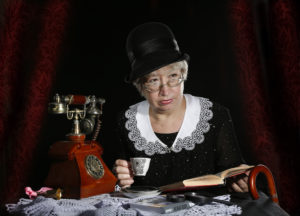
Have you read any of Agatha Christie’s books? If so, which ones? And what did you think?
Literature on point
John Emsley, “The poison prescribed by Agatha Christie: Thanks to the mystery writer, the deadly properties of thallium sulphate have become common knowledge,” Independent (20 July 1992).
Michael Gerard, The Poisonous Pen of Agatha Christie (Univ. of Texas Press, 2011)
Uwe Künzler, “Mit Arsen und Schwesternhäubchen. Aus der Giftküche der Agatha Christie,” Deutsche Apothekezeitung (1999)
Agatha Christie Limited, “The Pale Horse,” The Home of Agatha Christie (2009).
Benno Rießelmann and Volkmar Schneider, “Giftmore in den Kriminalromanen von Agatha Christie – Anmerkungen aus rechtsmedizinischer und toxilogischer Sicht” (manuscript, 2001).
Meghan Ross, “5 Pharmacist Facts about Agatha Christie,” Pharmacy Times (2015)
Sächsiches Apothekenmuseum Leipzig, Arzneimittel in todsicher Dosis: Die Pharmazeutin Agatha Christie (2003)

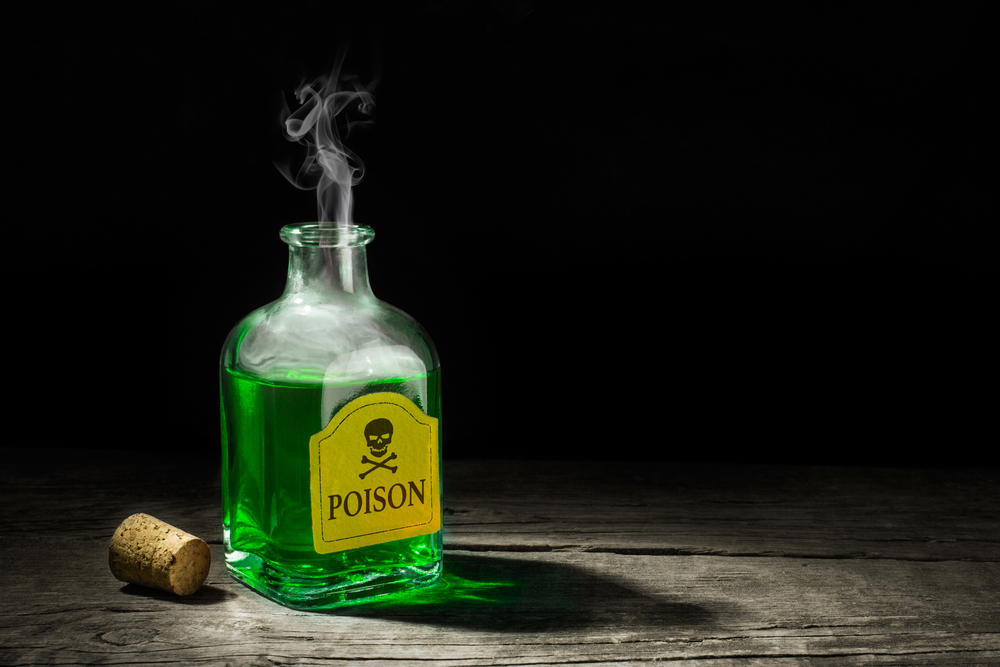


Very interesting. I like some of Christie’s mysteries but can’t stand Hercule Poirot. Didn’t know she had been a pharmacist. I wonder what poisons she would have used or known in 1810- apart from arsenic and digitalis ( under a different name.)
Hemlock, perhaps? I’m not sure what other poisons were popular in the early 19th century, but you might want to take a look at Deborah Blum’s The Poisoner’s Handbook. It contains a history of poisons and the medical community’s attempts to identify poisonings. Thanks for commenting, Nancy, and I’m glad you found the post interesting.
Curious as to why you mention 1810? Agatha Christie was from the 20th century. As noted above, she published her first book in 1920.
Good point, Rachel. I assume it was a typo. It’s still a good question.
I love Agatha Christie’s and have read nearly every one. I especially liked her focus on human nature, both good and bad, and how it impacts our behavior.
That’s one thing she does really well — her characters. Since you’ve read nearly every one, Becky, do you have a favorite Christie character? Thanks for commenting.